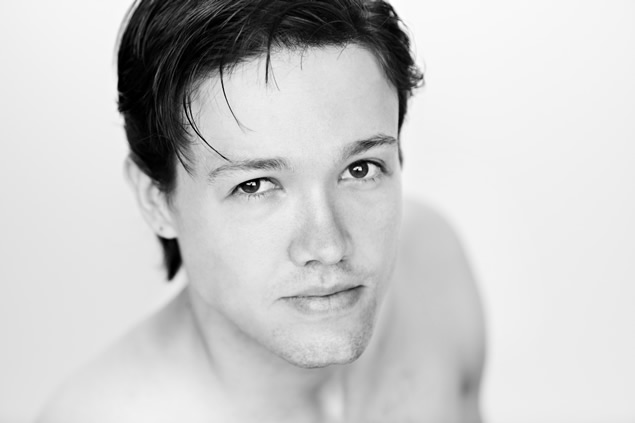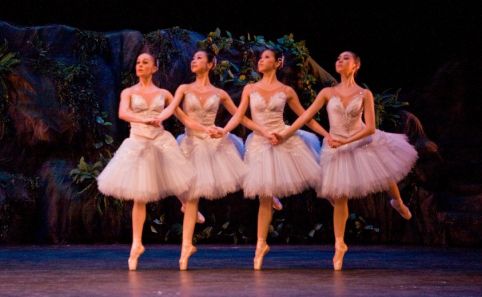There is magic in the story of ill-fated lovers, set to the music of Tchaikovsky and performed in dance. The Singapore Dance Theatre opened their 2012 performance season with Swan Lake. This is the 3rd time they are staging this production, having previously done so in 2007 and 2009. This was my first local ballet, and having seen the likes of Sylvie Guillem on stage before, I wasn’t quite sure what to expect. The gothic fairytale that is Swan Lake captures more depth than meets the eye, and SDT’s lead Rosa Park was phenomenal in her slow, exquisite resistance against Chen Peng’s (the Prince) promise of freedom…
Act 1 introduces us to Prince Siegfried celebrating his coming of age where he would ascend the throne as King. However, his mother The Queen reminds him that he must take a wife. She bestows upon him a crossbow and 2 goblets; one meant for his wife that he must choose at his birthday ball.
The performance got off to a shaky, almost painful start as dancers hopped onto stage eager but almost hyperactive. The lines were extremely messy and asymmetric, with little coordination. To make things worse this was one of the longest Acts, and it seemed to stretch on forever. The cringe-worthy performance was slightly vitiated though by Timothy Coleman’s performance of Benno, Prince Siegfried’s best friend. He was very charming onstage, and my friend S could not help but swoon.
Timothy Coleman (Benno)
In Act 2, Prince Siegfried and his friends arrive at the lake hoping to hunt some swans. He chances upon Odette, and sees her magically transform from a swan into a woman. She tells him of the spell cast by the evil sorcerer von Rothbart, which can only be broken by the promise of true and everlasting love. Prince Siegfried falls in love and promises to protect her, but von Rothbart appears. Daybreaks, and Odette and her swans depart.
Dance of the Four Cygnets
This Act was truly the saving grace of the entire performance. The entrance and performance of Rosa Park as Odette, the White Swan, can only be described as magical, and it was only till she left the stage when I realized I had been holding my breath. Rosa Park was exactly how I had pictured the White Swan in my mind- poised, peaceful, and yet, sadness. She is perhaps the main reason why I am looking forward to SDT’s future performances! The Petipa/Ivanov choreography of the Dance of the Four Cygnets was executed beautifully. When the swans departed and the lights came on for the intermission, I was already completely taken in- it was a far improvement from Act 1, and I couldn’t wait to see Rosa Park on stage again.
Rosa Park as Odile (Black Swan) and Chen Peng (Prince Siegfried)
In Act 3, the castle is celebrating Prince Siegfried’s birthday where von Rothbart arrives with his daughter, Odile (the Black Swan), disguised as Odette. Prince Siegfried, who mistakes her for Odette, declares his vow of love and marriage to her. Von Rothbart reveals the trick and everything falls into dismay.
Act 3 was most memorable for its staging. When the curtains lifted after the intermission a chorus of oohs echoed through the audience as the impeccable set took us to the opulence of the castle. The detail on the costumes was amazing. This time, the movement was more precise (perhaps because the dancers took turns in smaller groups and not en masse), and was fantastic at capturing the celebration of the ball. Yet, it later failed to capture the shock and devastation upon the revelation of von Rothbart’s deception. Perhaps they could have chosen a closer body substitute for Odette, who suddenly grew 2 sizes. The worst part was when Odette’s body double, after posing dramatically, fell out of character and shuffled off the platform she was on — we literally saw her lift the curtain and trot backstage, in full view in front of the audience. Nonetheless, it was an enjoyable scene, with more diverse chorography. Notorious for the Black Swan Pas de Deux, Rosa Park executed the 32 pirouettes effortlessly.
Act 4 concluded the performance, as Prince Siegfried rushes to the lake to see Odette. Von Rothbart arrives and they battle. Prince Siegfried defeats von Rothbart and the spell is broken. Odette and Prince Siegfried live happily ever after.
The ending however, was less than satisfactory. Despite the imprecision and asymmetry of Act 1 that was almost painful to watch, Act 4 was my least favourite scene because it brought a clumsy ending to a ballet renowned for its deliberate pace and choreography.
Compared to the tedious mess of the party celebrations in Act 1 which was prolonged unnecessarily, the supposedly climaxing battle between Prince Siegfried and von Rothbart was too short and less than satisfactory. While the elegant lifts and leaps were clearly testament to the dancers’ strength and precision, in less than 5 minutes, it was all over. The swans also seemed more focused on making the right moves and going in the right direction than capturing the true emotion of the story — absent was any indication of restraint yet helplessness in their movement that should have embodied their resignation of their tragic but inevitable fate to von Rothbart in his defeat of Prince Siegfried. Only one or two dancers showed any form of facial expression, the rest were more concerned with getting the technical movement over and done with.
The SDT chose an ending that was closer to the original 1877 ballet where Prince Siegfried tears off one of Von Rothbart’s wings thereby destroying his powers, but with an alternative that was either a genius in thematic recurrence or sheer laziness. Discovering the crossbow he had received from his mother as a birthday gift in Act 1 conveniently placed at the side of the stage (or, the marshes by the lake, we imagine), Prince Siegfried fires at von Rothbart who was perched at a cruelly disadvantageous position of the top of the rocks and in a clear line of shot. The arrow did not even leave the prop, and we assume Prince Siegfried’s triumph when von Rothbart topples off the rocks in a comic manner not unlike what you see on children’s television.
Maybe I write as the product of conditioning from Romeo and Juliet and too much Edgar Allen Poe, but I would have much preferred the tragic ending of the 1895 Mariinsky revival. In this ending, altered by Tchaikovsky’s brother Modeste, the spell cannot be broken because of Prince Siegfried’s accidental vow to Odette, and the lovers drown themselves in the lake, causing von Rothbart to lose his powers and die. Perhaps this would have better carried the emotion of a beautiful creature trapped under a vengeful curse that the only transcendence lays in death — which too, can be beautiful.
Rosa Park as Odette
The story of a love that transcends form and life is not uncommon, but the story of Swan Lake is not the love of humans that so often imperfect and so often fails us. It is the love of a swan. Celtic mythology believes that when the inhabitants of the Otherworld require passage into our realm of life, they travel as swans in pairs, coming to life from death together. The reincarnation of love in swan form is mirrored in the Irish myth of Caer Ibormeith, whose story bears an uncanny resemblance to Swan Lake. Instead of turning the cursed swan back to human form, the rescuer Aengus, god of love, turns into a swan and flies away with his loved one.
The perfect finale would then be, as performed by the San Francisco Ballet in 2009, the apotheosis of the lovers as swans, flying past the moon in their ascend to heaven, finally together.
[The Singapore Dance Theatre will be staging performances at least once a month till their 2012 season culminates in December with Sleeping Beauty. Their fondly beloved and wildly popular Ballet Under the Stars returns on 20- 22 July, followed by their annual triple bill Masterpiece in Motion on 24-25 August at the Esplanade. We can’t wait.]
***
Article contributed by: Heidi Tan (Law 2)







